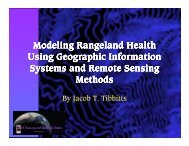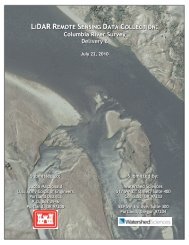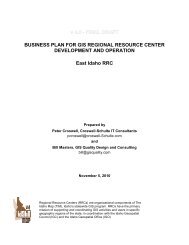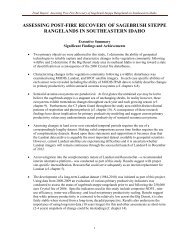Comparison of Image Resampling Techniques for Satellite Imagery
Comparison of Image Resampling Techniques for Satellite Imagery
Comparison of Image Resampling Techniques for Satellite Imagery
Create successful ePaper yourself
Turn your PDF publications into a flip-book with our unique Google optimized e-Paper software.
Final Report: Assessing Post-Fire Recovery <strong>of</strong> Sagebrush-Steppe Rangelands in Southeastern Idaho<strong>Comparison</strong> <strong>of</strong> <strong>Image</strong> <strong>Resampling</strong> <strong>Techniques</strong> <strong>for</strong> <strong>Satellite</strong> <strong>Image</strong>ryHeather Studley, Idaho State University, GIS Training and Research Center, 921 S. 8th Ave.,Stop 8104, Pocatello, ID 83209-8104 USAKeith T. Weber, GIS Director, Idaho State University, GIS Training and Research Center, 921 S.8th Ave., Stop 8104, Pocatello, ID 83209-8104 USA. e-mail webekeit@isu.eduABSTRACT<strong>Image</strong> resampling is a process used to interpolate the new cell values <strong>of</strong> a raster image during a resizingoperation. There are many resampling methods available, through a variety <strong>of</strong> plat<strong>for</strong>ms, including GISand image-editing s<strong>of</strong>tware. Each resampling method has strengths and weaknesses which should beconsidered carefully. The purpose <strong>of</strong> this paper was not to find a “best” method, but rather to explorehow different methods implemented by different s<strong>of</strong>tware vendors (in this case, ArcGIS and Paint ShopPro) compared. Aggregated Average and Nearest Neighbor are two commonly used resampling methods,but numerous other methods are available (e.g., bicubic, bilinear, cubic convolution, pixel resize, andweighted average). To compare these methods, Landsat imagery was iteratively resampled from 28.5 to100 meters per pixel (mpp) using each <strong>of</strong> the available methodologies. Correlation coefficients weredetermined comparing each resampled image against imagery resampled using 1) aggregated average and2) nearest neighbor. Resulting correlation coefficients (R 2 ) ranged from 0.98 to 0.34. Correlation betweenaggregated average and nearest neighbor was relatively low (R 2 = 0.41) as was the correlation betweentwo bilinear interpolation results (R 2 = 0.393) as implemented by different s<strong>of</strong>tware programs. It wasconcluded that resampling methods should be considered carefully and tested be<strong>for</strong>e selecting a s<strong>of</strong>twareprogram or technique, as different programs can implement the same method very differently.KEYWORDS: aggregated average, nearest neighbor, bicubic, bilinear, interpolation, cubic convolution,pixel resize, weighted average185
Final Report: Assessing Post-Fire Recovery <strong>of</strong> Sagebrush-Steppe Rangelands in Southeastern IdahoINTRODUCTION<strong>Image</strong> resampling is a process by which new pixel values are interpolated from existing pixel valueswhenever the raster's structure (number <strong>of</strong> rows and columns) is modified such as during projection,datum trans<strong>for</strong>mation, or cell resizing operations (Wade and Sommer, 2006). Various resamplingmethods can be employed to resize an image (Corel Corp., 2007) and when an image is enlarged orreduced, changes are necessarily made to the value assigned to each pixel. To reduce an image, entirerows and columns are removed, while the enlargement <strong>of</strong> an image requires the opposite change byadding rows and columns <strong>of</strong> pixels. In both cases, the spatial extent (minimum and maximum X and Ycoordinates) <strong>of</strong> the imagery is unchanged and only the raster's structure is modified. The effect <strong>of</strong> imageresampling is a concern <strong>for</strong> image quality in general, and when dealing with remotely sensed data <strong>for</strong>scientific interpretation, data integrity (i.e., how closely the interpolated value matches the original value<strong>of</strong> each pixel) becomes a concern as well. This is because raster images store data within the feature(pixel) itself as <strong>for</strong> example, each pixel from a satellite image represents a measured surface reflectancevalue derived from a satellite or airborne sensor.The enlargement <strong>of</strong> satellite imagery (i.e., increasing the number <strong>of</strong> rows and columns) is typically not <strong>of</strong>concern relative to data integrity issues as the rows and columns <strong>of</strong> pixels added are simply duplicates <strong>of</strong>existing pixels. This is particularly true when the enlargement factor is a whole number, but notnecessarily true when imagery is enlarged fractionally (e.g., spatial resolution <strong>of</strong> an image is changedfrom 15 meters per pixel [mpp] to 10 mpp) as this specific procedure does require interpolation. Incontrast, the reduction <strong>of</strong> an image means fewer rows and columns (and hence fewer pixels) will be usedto represent the same geographic features across the same spatial extent. A fairly common resamplingtask involves the conversion <strong>of</strong> satellite imagery at a relatively fine spatial resolution (e.g., 10 mpp) to amore coarse resolution (e.g., 30 mpp) to readily accommodate comparison with imagery from anothersatellite sensor. In this scenario, blocks <strong>of</strong> pixels (kernels) are involved in an iterative resampling process.The value <strong>of</strong> each pixel within each kernel is evaluated and a new value calculated <strong>for</strong> the output pixel inthe new “resampled” image layer. To effect this change various <strong>for</strong>ms <strong>of</strong> interpolation have beendeveloped to minimize data integrity losses as a result <strong>of</strong> resizing. Hence, the study described in thispaper was designed to enable a better understanding <strong>of</strong> the consequences <strong>of</strong> resampling satellite imageryduring a reduction-type resize operation.Commonly used resampling methods are:Aggregated AverageThe arithmetic mean <strong>of</strong> all pixels within each kernel is used as the value <strong>for</strong> the new image pixel. Usingaggregated average (AA) all pixels are equally weighted but like all metrics using mean, the output pixelwill be strongly influenced by outlier or extreme values that belong to the kernel (Przydatek et al., 2003;Wagner 2004; Li et al., 2005).BicubicBicubic interpolation is a variation <strong>of</strong> cubic interpolation (see below) where the process is per<strong>for</strong>med inboth X and Y directions (Losinger, 2006). This method is more accurate than nearest neighbor or bilinearinterpolation, but slower to run (Goldsmith, 2009). Paint Shop Pro (PSP) graphics s<strong>of</strong>tware specificallydefines its bicubic method as using 16 neighboring pixels in a 4x4 pixel neighborhood (Corel Corp.,2007).186
Final Report: Assessing Post-Fire Recovery <strong>of</strong> Sagebrush-Steppe Rangelands in Southeastern IdahoBilinear InterpolationBilinear interpolation uses the arithmetic mean <strong>of</strong> the four pixels nearest the focal cell to calculate a newpixel value. This resampling method tends to produce a “smoother” image (Goldsmith, 2009), retainsbetter positional accuracy than nearest neighbor resampling (Verbyla, 2002), but may introduce newvalues never found in the original image with some blurred edges introduced as well (Goldsmith, 2009).As applied within PSP, the new value is based on the average <strong>of</strong> four neighboring cells in a 2x2 kernel(Corel Corp., 2007) (Figure 1).Figure 1. Bilinear Interpolation: The centers <strong>of</strong> the cells <strong>of</strong> the input raster are marked with gray dots. Thegreen grid represents the output raster. The red dot marks the center <strong>of</strong> the target cell (in yellow). Theorange dots are the four nearest cells from the input raster that will be used to calculate the value <strong>for</strong> thedesired output cell.Note: <strong>Image</strong> courtesy <strong>of</strong> ESRI.Cubic ConvolutionCubic convolution (CC) resampling uses a weighted average <strong>of</strong> the 16 pixels nearest to the focal cell(Figure 2) and produces the smoothest (or most continuous) image compared to bilinear interpolation ornearest neighbor resampling (Verbyla, 2002; Huber, 2009). However, CC resampling takes approximately10 to 12 times longer to process the computation than nearest neighbor (eXtension, 2008; Huber, 2009).Figure 2. Cubic Convolution: Again, the gray dots represent the centers <strong>of</strong> the input raster cells and the greengrid represents the output raster. The target cell is yellow with the red dot showing the center. For cubicconvolution the 16 nearest cells (orange dots) are used <strong>for</strong> input to calculate the new output value.Note: <strong>Image</strong> courtesy <strong>of</strong> ESRI.187
Final Report: Assessing Post-Fire Recovery <strong>of</strong> Sagebrush-Steppe Rangelands in Southeastern IdahoAffects <strong>of</strong> resamplingRemotely sensed data, be they from satellite or airborne sensors, are incredibly variable. Spatialresolutions can be very coarse (>100 mpp) to very fine (< 0.1 mpp) and choosing which scale to use <strong>for</strong> astudy can be a difficult process, with limitations including availability <strong>of</strong> fine resolution imagery, costconstraints, and data processing considerations. With a variety <strong>of</strong> plat<strong>for</strong>ms to choose from, it is fairlycommon that imagery from one plat<strong>for</strong>m may need to be compared to imagery from a different plat<strong>for</strong>m(e.g., SPOT 4 [20 mpp] and SPOT 5 [10 mpp]).In order to compare data from one spatial resolution to another, imagery from the finer resolution aretypically resampled to match the spatial resolution <strong>of</strong> the coarser imagery. This type <strong>of</strong> resampling canhave substantial effects on the integrity <strong>of</strong> the data being compared (João, 2001). Gotway and Young(2002) provided a brief overview concerning incompatibility <strong>of</strong> spatial data and looked at some <strong>of</strong> themethods used to overcome that concern. Bian and Butler (1999) looked at the three most common types<strong>of</strong> resampling (1-averaging; uses the averaged value <strong>of</strong> a kernel <strong>for</strong> the output pixel, 2-central-pixel; usesthe most centrally located pixel <strong>of</strong> a kernel <strong>for</strong> the output value, and 3- median value; uses the statisticalmiddle value in a kernel dataset as the output) and found that averaging had the most predictablestatistical errors. It is noted however, that Goodin and Henebry (2002) found averaging may notaccurately preserve the spatial properties desired <strong>for</strong> research.Nearest neighbor (NN) and aggregated average (AA) are two commonly used resampling methodsapplied to remote sensing imagery. NN is useful <strong>for</strong> its speed and ability to maintain the integrity <strong>of</strong>categorical data while AA can accurately preserve mean values <strong>of</strong> images across many levels <strong>of</strong>aggregation (Bian and Butler, 1999). The purpose <strong>of</strong> this study was to compare the results <strong>of</strong> numerousresampling methods to the results <strong>of</strong> NN and AA resampling, and thereby better understand the affect <strong>of</strong>resampling and its potential implications on the introduction and propagation <strong>of</strong> error.MethodsOne Landsat 5 TM scene (path 39 row 30) acquired on June 13, 2006 was used in this study. Prior toapplying experimental resampling, the imagery was corrected <strong>for</strong> atmospheric effects using the Cos(T)method (Chavez, 1996) available in Idrisi Andes. A normalized difference vegetation index (NDVI) wascalculated as a simple band ratio <strong>of</strong> the red and near-infrared bands (bands 3 and 4) following Rouse et al(1974). NDVI was selected <strong>for</strong> use in this study as it is a very common application <strong>for</strong> satellite imagerymaking the reported results more meaningful.Idrisi Andes, ESRI ArcGIS 9.3, and Corel Paint Shop Pro X2 (PSP) were used to per<strong>for</strong>m resampling(aggregated average, bicubic, bilinear, cubic convolution, nearest neighbor, pixel resize, and weightedaverage) <strong>of</strong> the NDVI layer (Table 1). In all cases, Landsat-derived NDVI imagery was resampled fromits native 28.5 mpp to 100 mpp. In total, eight resampled layers were produced and using these layers,100 pixel-values were extracted using the ArcGIS sample tool. The extracted values <strong>for</strong> bicubic, bilinearinterpolation, cubic convolution, pixel resize, and weighted average were then compared to pixel valuesderived using AA and NN resampling methods. AA and NN values were also compared as were theresults <strong>of</strong> bilinear interpolation using ESRI ArcGIS and PSP. Statistical comparisons were facilitated bycalculating a correlation coefficient (R 2 ) between each pair <strong>of</strong> image values (n = 12; Table 2).189
Final Report: Assessing Post-Fire Recovery <strong>of</strong> Sagebrush-Steppe Rangelands in Southeastern IdahoTable 1. NDVI image layers were systematically resampled using a variety <strong>of</strong> techniques and s<strong>of</strong>twareapplications.<strong>Resampling</strong> technique Idrisi Andes ESRI ArcGIS Corel Paint Shop ProAggregated Average (AA) *Bicubic *Bilinear interpolation * *Cubic convolution *Nearest Neighbor (NN) *Pixel resize *Weighted average *Table 2. Pairs <strong>of</strong> resampled images were statistically compared using linear regression and correlationcoefficients (R 2 )Method AA BC BL CC NN PR WAAA * * * * * *BC * *BL * * *CC * *NN * * * * * *PR * *WA * *RESULTS AND DISCUSSIONThe most similar resampling results (R 2 = 0.984) were found between the bicubic and AA methods(Figure 4a). PSP’s calculations <strong>for</strong> Bilinear interpolation resampling were also very similar to AA values(R 2 = 0.964) (Figure 4b). This is not surprising as all three resampling methods calculate output values byaveraging values within the input kernel. The only real change from one process to the next is the size <strong>of</strong>the kernel. The kernel size <strong>for</strong> AA is unknown, but it is probably close to 16 pixels given how closely itcompares to PSP’s bicubic results. Some variation can be expected since it is not uncommon <strong>for</strong> s<strong>of</strong>twarecompanies to have specific, patented algorithms that are slightly different from others. This concept isfurther illustrated in Figure 7 which compares results from ArcGIS’s bilinear resampling with PSP’sbilinear resampling method. The resulting R 2 value <strong>of</strong> only 0.393 illustrated that, even though resultsshould be fundamentally identical, each product produced drastically different values.y = 9.1344x - 7.045R² = 0.9838y = 6.3144x + 150.43R² = 0.4112(A) Bicubic (PSP)190(B) Bilinear
Final Report: Assessing Post-Fire Recovery <strong>of</strong> Sagebrush-Steppe Rangelands in Southeastern Idahoy = 8.3503x + 22.657R² = 0.9636y = 6.2977x + 151.22R² = 0.3893(C) Bilinear (PSP)(D) Cubic Convolutiony = 7.6619x + 42.27R² = 0.508y = 8.3832x + 23.138R² = 0.9018(E) Pixel Resize (PSP)(F) Weighted Resize (PSP)Figure 4. Various resampling method results compared to the results <strong>of</strong> Aggregated Average resampling.Graphs are shown with linear trendlines, slope and intercept, and correlation coefficient (R 2 ) values.The resampling method most similar to NN was CC resampling (R 2 = 0.963) (Figure 5d), and ArcGIS’sbilinear resampling (R 2 = 0.960) (Figure 5b). However, it must be remembered that neither <strong>of</strong> theseoptions would maintain original categorical data values as NN will and both require more computationalpower relative to NN. Bilinear interpolation does not require as much computational power as CC, so <strong>for</strong>very large images it may be a suitable substitution to achieve results similar to NN but in less time thanCC.y = 0.5431x + 122.89R² = 0.3635y = 0.9401x + 26.107R² = 0.9605(A) Bicubic (PSP)191(B) Bilinear
Final Report: Assessing Post-Fire Recovery <strong>of</strong> Sagebrush-Steppe Rangelands in Southeastern Idahoy = 0.5022x + 139.65R² = 0.3671y = 0.9661x + 16.342R² = 0.963(C) Bilinear (PSP)y = 0.6254x + 86.851R² = 0.3495(D) Cubic Convolutiony = 0.5178x + 135.37R² = 0.3613(E) Pixel Resize (PSP)(F) Weighted Resize (PSP)Figure 5. Various resampling method results compared to the results <strong>of</strong> Nearest Neighbor resampling.Graphs are shown with linear trendlines, slope and intercept, and correlation coefficient (R 2 ) values.Figure 6 shows that NN and AA produce very different results (R 2 = 0.409) and imagery resampled usingthese methods are not directly comparable. This is not surprising however, considering how different theresampling methods are. This finding also explains why the other methods tested either compared betterwith either AA (PSP’s bicubic, bilinear, and weighted average) , NN (ArcGIS’s bilinear and PSP’s CC),or neither (PSP’s Pixel Resize).y = 0.5716x + 123.24R² = 0.4098Figure 6. <strong>Comparison</strong> <strong>of</strong> values obtained by resampling with the Nearest Neighbor and Aggregated Averagemethods.192
Final Report: Assessing Post-Fire Recovery <strong>of</strong> Sagebrush-Steppe Rangelands in Southeastern Idahoy = 0.5415x + 122.89R² = 0.3927Figure 7. <strong>Comparison</strong> <strong>of</strong> values obtained by using an ArcGIS Bilinear resampling and Corel’s PSP Bilinearresampling method.CONCLUSIONSThe purpose <strong>of</strong> this study was not to determine the best method <strong>for</strong> image resampling but rather to learnhow various methods <strong>of</strong> image resampling compare to NN and AA as these are most commonly used.Atkinson (2001) raised a concern that those using remotely sensed data tended to choose images withoutproperly considering if the pixel size <strong>of</strong> that image was appropriate <strong>for</strong> the study being conducted. Thesame could be said <strong>for</strong> resampling methods. There are a many options available <strong>for</strong> resampling images,and all options should be considered and tested be<strong>for</strong>e applying a method.Additional considerations include the degree to which data values need to be maintained (especially whencategorical data is resampled), whether the resulting dataset needs to be statistically or spatially accurate,how much processing power is available to per<strong>for</strong>m the resampling, and what s<strong>of</strong>tware is available toper<strong>for</strong>m the resampling.It was determined that image-editing s<strong>of</strong>tware such as Corel’s Paint Shop Pro can be used to per<strong>for</strong>mimage resampling, with results comparable to those created from remote sending - or GIS-specifics<strong>of</strong>tware. However, due to proprietary differences in algorithms, care needs to be taken to make sure theresults from one resampling s<strong>of</strong>tware application can be compared to the results from another. Forexample, it is not recommended that another image-editing s<strong>of</strong>tware (e.g., Adobe’s Photoshop) be used inlieu <strong>of</strong> PSP without prior testing.Based upon results presented in this paper, it is important to carefully select the most appropriateresampling technique <strong>for</strong> a given set <strong>of</strong> circumstances and seems most prudent to apply the sameresampling technique using the same s<strong>of</strong>tware to all imagery that is part <strong>of</strong> a given study. Lastly, it isnoted that NN is a unique resampling process in that it is the only method that does not interpolate newvalues into the dataset, and is there<strong>for</strong>e the only method that should be used <strong>for</strong> categorical data.ACKNOWLEDGEMENTSThis study was made possible by a grant from the National Aeronautics and Space AdministrationGoddard Space Flight Center (NNX08AO90G). ISU would also like to acknowledge the IdahoDelegation <strong>for</strong> their assistance in obtaining this grant.193
Final Report: Assessing Post-Fire Recovery <strong>of</strong> Sagebrush-Steppe Rangelands in Southeastern IdahoLITERATURE CITEDAtkinson, P., 2001. Geostatistical Regularization in Remote Sensing. 237-260 in N. Tate, & P. Atkinson(Ed.), Modelling Scale in Geographical In<strong>for</strong>mation Science. Chinchester: John Wiley & Sons Ltd.Bian, L. and R. Butler, 1999. Comparing Effects <strong>of</strong> Aggregation Methos on Statistical and SpatialProperties <strong>of</strong> Simulated Spatial Data. Photogrammetric Engineering & Remote Sensing , 65 (1), 73-84Chavez, P.S., 1996. <strong>Image</strong> based atmospheric corrections — Revisited and improved, PhotogrammetricEngineering and Remote Sensing, 62:1025-1036Corel Corp., 2007. Resizing <strong>Image</strong>s. Corel Paint Shop Pro Photo X2 HelpCorel Corp., 2009. Answer Id 757099. URL = http://corel.custhelp.com visited June 17, 2009Dodgson, N.A., 1992. <strong>Image</strong> <strong>Resampling</strong>. University <strong>of</strong> Cambridge, Computer Laboratory. Cambridge:University <strong>of</strong> Cambridge Computer LaboratoryESRI, 2008. ESRI Support Center. visited May 27, 2009, from FAQ: What's the Difference betweenNearest Neighbor, Bilinear Interpolation and Cubic Convolution?ESRI, 2009. Spatial Analyst: Cell size and resampling in analysis. ArcGIS HelpeXtension, 2008. Remote Sensing <strong>Resampling</strong> Methods. URL = http://www.extension.org/pages/Remote_Sensing_<strong>Resampling</strong>_Methods visited May 11, 2009Goldsmith, N. 2009. <strong>Resampling</strong> Raster <strong>Image</strong>s. URL = http://www.jiscdigitalmedia.ac.uk/stillimages/advice/resampling-raster-images/ visited May 11, 2009Goodin, D.G. and G.M. Henebry, 2002. The Effect <strong>of</strong> Rescaling on Fine Spatial Resultion NDVI Data: ATest using Multi-resolution Aircraft Sensor Data. International Journal <strong>of</strong> Remote Sensing , 23 (18),3865-3871Gotway, C.A. and L.J. Young, 2002. Combining Incompatible Spatial Data. Journal <strong>of</strong> the AmericanStatistical Association , 97 (458), 632-648Huber, W. 2009. Map Algebra: <strong>Resampling</strong>. URL = http://www.quantdec.com/SYSEN597/GTKAV/section9/map_algebra.htm visited May 2009João, E., 2001. Measuring Scale Effects Caused by Map Generalization and the Importance <strong>of</strong>Displacement. Pages 161-179 in N. Tate, & P. Atkinson (Ed.), Modelling Scale in GeographicalIn<strong>for</strong>mation Science. Chinchester: John Wiley & Sons Ltd.Kay, D.C. and W. Steinmetz, 2005. Paint Shop Pro 9 <strong>for</strong> Dummies. Hoboken: Wiley, Inc.194
Final Report: Assessing Post-Fire Recovery <strong>of</strong> Sagebrush-Steppe Rangelands in Southeastern IdahoLi, Z., W. Trappe, Y. Zhang, and B. Nath, 2005. Robust Statistical Methods <strong>for</strong> Securing WirelessLocalization in Sensor Networks. IEEE 09/05:91-98Losinger, C., 2006. Resizing (updated <strong>for</strong> v4.0). Smaller Animals S<strong>of</strong>tware vBulletin – ImgSourcearticles. URL = http://www.smalleranimals.com/v<strong>for</strong>um/showthread.php?t=1878 visited June 17, 2009Przydatek, B., D. Song, and A. Perrig, 2003 SIA: secure in<strong>for</strong>mation aggregation in sensor networks, inSenSys ’03: Proceedings <strong>of</strong> the 1st International Conference on Embedded Networked Sensor Systems,255–265Rouse, J.W. Jr., R.H. Haas, D.W. Deering, J.A. Schell, and J.C. Harlan, 1974. Monitoring the VernalAdvancement and Retrogradation (Green Wave Effect) <strong>of</strong> Natural Vegetation, Greenbelt: NASA/GSFCType III Final Report, 371 pp.Shea, S. 2009. Resizing Versus <strong>Resampling</strong>: Corel Paint Shop Pro Photo Basics – Lesson 4. About.com:Graphics S<strong>of</strong>tware. URL = http://graphicss<strong>of</strong>t.about.com/od/paintshoppro/ig/lesson4/Resizing-Versus-<strong>Resampling</strong>.htm visited June 17, 2009Verbyla, D.L., 2002. Practical GIS analysis. London: Taylor & FrancisWade, T., and S. Sommer, 2006. A to Z GIS. Redlands: ESRI PressWagner, D., 2004. Resilient aggregation in sensor networks, in SASN ’04: Proceedings <strong>of</strong> the 2nd ACMworkshop on Security <strong>of</strong> ad hoc and sensor networks, 78–87Recommended citation style:Studley, H. and K. T. Weber, 2011. <strong>Comparison</strong> <strong>of</strong> <strong>Image</strong> <strong>Resampling</strong> <strong>Techniques</strong> <strong>for</strong> <strong>Satellite</strong> <strong>Image</strong>ry.Pages 185-196 in K. T. Weber and K. Davis (Eds.), Final Report: Assessing Post-Fire Recovery <strong>of</strong>Sagebrush-Steppe Rangelands in Southeastern Idaho. 252 pp.195
Final Report: Assessing Post-Fire Recovery <strong>of</strong> Sagebrush-Steppe Rangelands in Southeastern Idaho[THIS PAGE LEFT BLANK INTENTIONALLY]196
















